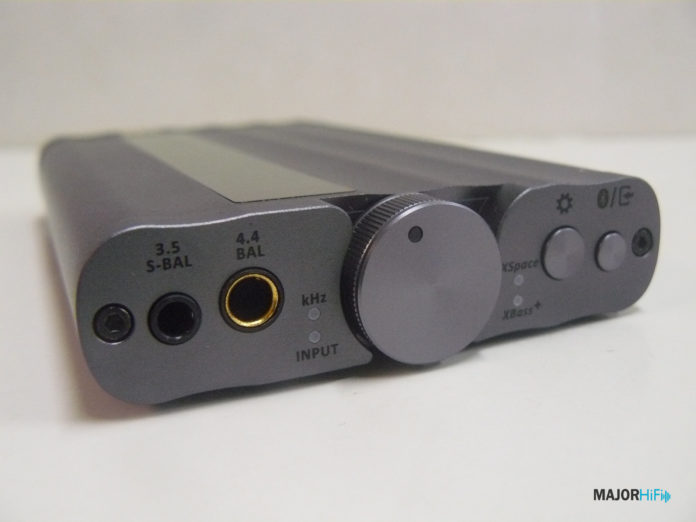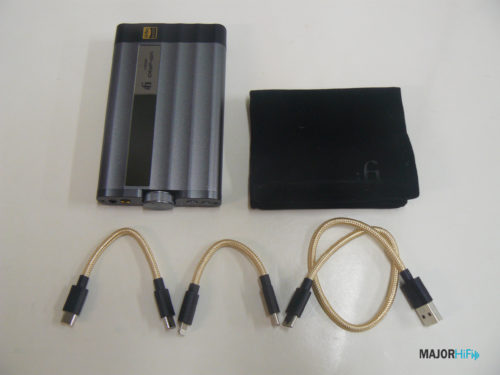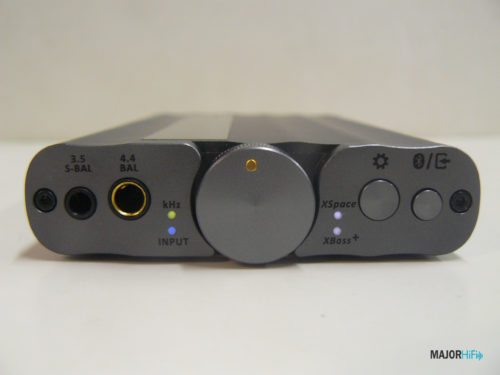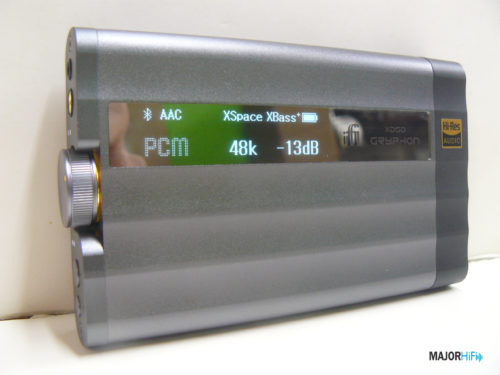It was only a few months ago that iFi released the Go Blu, a Bluetooth DAC/Amp for all types of listeners. Now, only a few months later, iFi has released yet another Bluetooth device. This time it’s a much more high-end model than the Go Blu, going for the price of $599. Is the Gryphon worth all that money over other Bluetooth amps?
What You Get
- xDSD Gryphon
- USB to USB C
- USB C to USB C
- USB C to Lightning
- Drawstring bag
- Manual
- Warranty
Build
The look of the Gryphon is very similar to the former xCAN and xDSD on which it’s built. This new model has a lot of added heft and its design is a lot more ridged than I remember from the previous iterations of this line. Its biggest inclusion is its shiny new OLED screen that shows you important information like sample rate, XBass, and Xspace functionality, battery life, Bluetooth CODEC, and volume. If iFi isn’t going to release a supplemental app, this is a fine way to show you how your device is working. What’s important to note here is that this display operates using SilentLine technology, meaning no electronic noise is added to the system.
If you’ve used one of iFi’s mini DAC/Amps before, then the Gryphon should be familiar territory for you. You have 3.5mm and 4.4mm headphone inputs on the front, just like the hip-dac. The volume pot sits firmly in the middle of the face and can rotate all the way around without stopping. To its right are the XBass and XSpace control where you can activate them individually or both at the same time. The last button on the face is an input selector that also works to put the Gryphon in pairing mode for Bluetooth connection. You can cycle through Bluetooth, USB, SPDIF, and Line input.
On the rear side of the Gryphon, you have a couple of notable plugs and switches. The switch all the way to the left is a mode adjustment for the XBass control. It gives you the options to switch between bass, presence, and a combination of the two. This controls whether or not you want a mid-range bump or a tighter resonance to be active when using XBass.
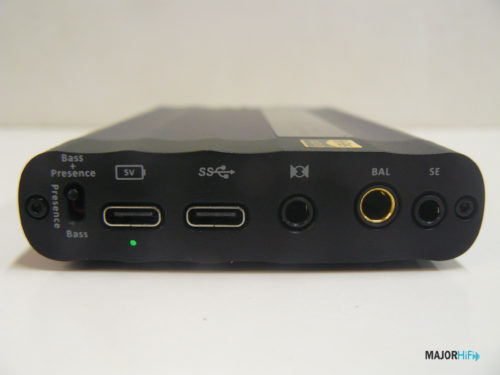
Two USB type C ports are used for battery charging, and for data transfer. I tried hardwiring my unit to my iPhone via the provided lightning to type C connector they provide for you, but I never had any success getting it to work properly. It could be that this cable isn’t MFI certified but I’m unsure, as trying an Apple camera adapter also gave me no success. No matter, as SPDIF, 4.4mm balanced, and 3.5mm single-ended ports are also provided here, giving you plenty of options to connect to any source. Lastly, IEMatch makes a return when looking at the bottom of the device, letting you switch between 4.4mm and 3.5mm connections.
Design
Taking a look inside of the Gryphon, the system uses a Burr-Brown chipset for DAC conversion with the latest QCC 5100 Bluetooth 5.1 technology. This is also supported by a globe master clock to help with jitter. With the Burr-Brown chip, you’re advertised to get bit-perfect sampling and MQA streaming capabilities. You’ll also have access to the latest formats, such as LDAC, and aptX HD, with higher-quality formats, which are supported over a wired connection like PCM up to 768kHz or DSD 512.
XSpace
So far, my favourite implementation of iFi’s Xspace feature has been on the IDSD Signature and Go Blu, but the Gryphon takes it to another level. By itself, the Gryphon adds good separation and more articulate layers to the soundstage, but on a much more linear level that doesn’t provide much more depth than the headphones already have. This all changes when Xspace is activated, as the sound becomes a sphere around your head. You can experience some great immersion with IEMs, but plug in an open-back headphone, and it’s like there never was a stereo field in the first place. With all the talk of spatial audio, it’s easy to forget how great this type of experience is.
One of the only downsides is the weight of certain sounds. Although the sound field is expansive, it adds an airy texture to whatever you might be listening to. Activating XBass helps, but some impact has a chance to smooth out and become less solidified depending on genre specifics. I loved using XSpace with movie soundtracks, classic rock, jazz, and ambient music, but other genres like metal and electronic didn’t have as much drive to them. With the Gryphon, I used the Audeze LCD 5, and HiFiMAN Sundara as open-backs to test with a few IEMs like the Kinera Nanna thrown in to see how far Xspace could go. The results were all equally gratifying, providing me with a luscious soundscape that floated around me with impeccable depth.
XBass II
Switching over to iFi’s patented XBass feature, the Gryphon once again impresses with its improvements in adding effective bass detail to any headphone. When I started playing around with XBass while listening to the Sundara, I could immediately tell why this version was superior to past implementations. The bass here isn’t as pushed forward and instead offers a more subtle extension in detail.
It works as if the function is to fill in bass texture where the headphone might be missing some. For example, when I’m listening to the Sundara the bass has a more perceivable feel to it, adding vibrating tones and increased depth. Past XBass features lifted the sub-bass almost to an extreme, while others pushed the mid-bass resonance, giving every headphone a warm timbre which you may not always want. Other headphones like the Sennheiser 660s are given a much more focused clarity, with the XBass turned off sounding muddier in comparison.
Summary
Using the Gryphon for a number of hours my thoughts are mostly positive, however, all of those qualities show themselves in much more affordable devices like the Go Blu which leaves me conflicted over whether I would recommend this or not. XBass and XSpace sound awesome, and the expansion of adding presence is a great new way to control bass resonance. XSpace works virtually the same as more recent iFi models, but still sounds great with most open-back headphones and even some select IEMs, but you don’t have to spend $599 to hear it.
Then there’s power, where the Gryphon reminds me more of the IDSD Neo than the Signature. It can power some high impedance headphones, but I always found myself booting into turbo mode with little headroom to manage. Everything about this Bluetooth amp is functional and sounds great, but for its price, it’s hard for me to see its value when the Go Blu and Hip-Dac V2 accomplished most of what it could do for less.
| Pros | Cons |
|
|
The iFi xDSD Gryphon is available at Audio46.
Compare the ranking of various headphones, earbuds and in-ear monitors using our tools.
Discuss this, and much more, over on our forum.
---MAJORHIFI may receive commissions from retail offers.


